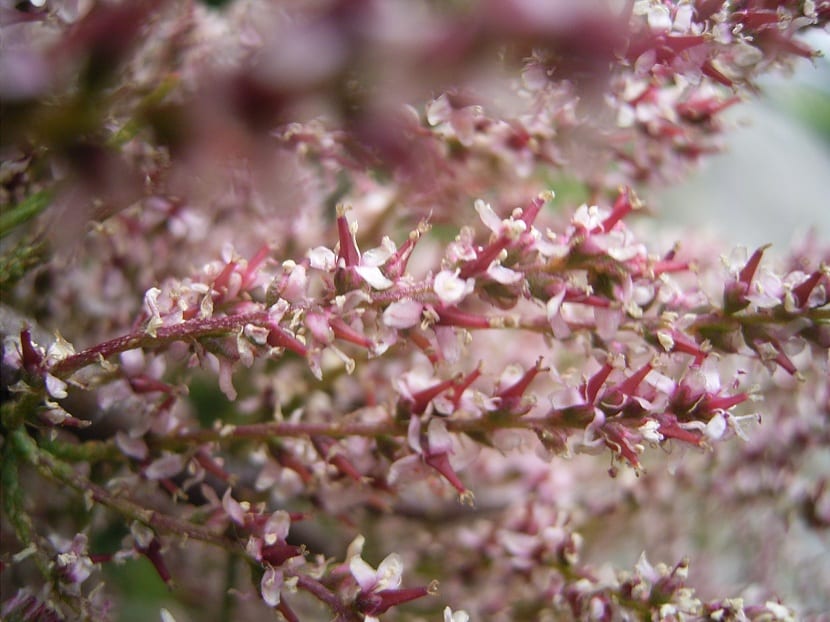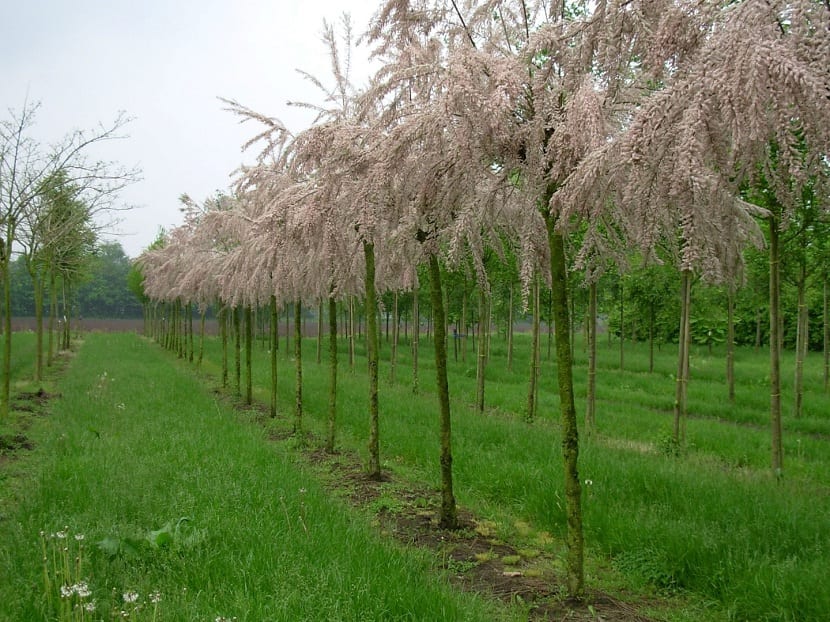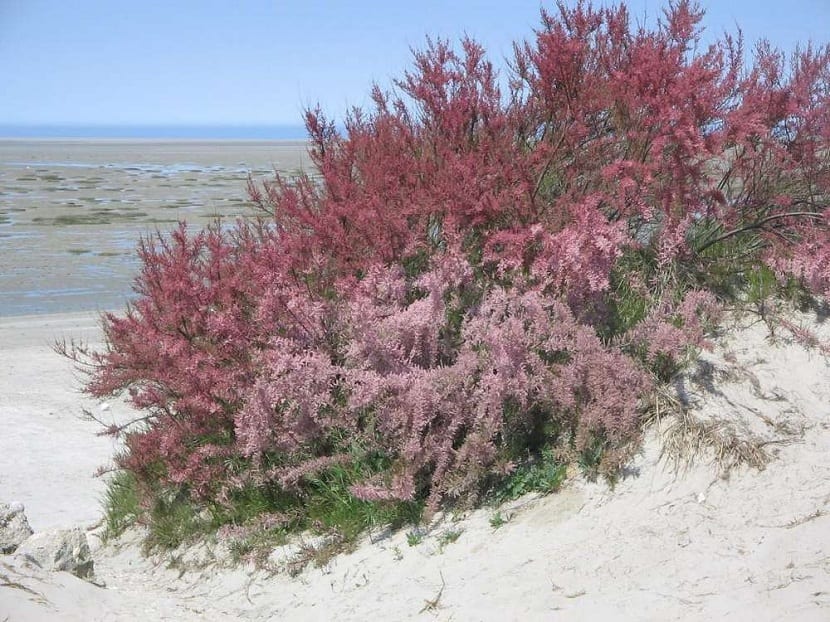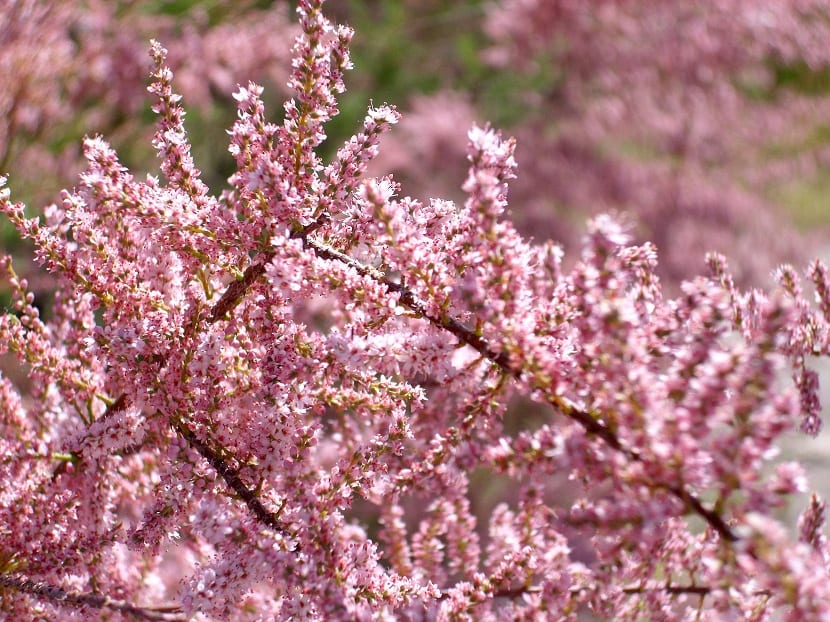
Today we are going to talk about a very interesting bush in the world of botany. It is a variety of tamarisk. Specifically, this article will deal with the tamarix gallica. Among their common names we can find that of taraje, atarfe, gatell, tamarindo, tamariz, taraga and taray. It belongs to the Tamaricaceae family. It has a good contribution to ornamentation and is widely used for decoration.
In this article we are going to show you how you have to take care of it and what it needs to be able to offer greater ornamental value.
Key features

It comes from Western Europe. If your care is correct, you are able to reach up to 4 meters high and up to 6 meters wide. This makes it almost become a tree rather than a bush. The tamarix gallica it uses anthophiles to be able to pollinate its flowers and thus expand through spaces. The flowers are of the hermaphroditic type.
Among its leaves we find the deciduous type. It is capable of attracting wildlife, so it is more recommended if we want to have a more "real" garden. Not only will some insects come to pollinate our garden and favor its growth, but fauna such as birds can also be attracted to the tamarisk.
These shrubs are characterized by having a fairly light appearance but feathery by their branches. Its foliage is quite fine and of a glaucous green color. What is most striking about this shrub is undoubtedly its floral growth. The leaves have a helical arrangement and cover each other as if they were tiny tiles.
The flowers are from pink or white in color and typically only 2-3mm in diameter. It compensates for this by growing together and in fairly dense clusters with many units and which usually reach 4 cm in length. The flowering time takes place in summer, since this species needs a higher temperature to be able to develop them.
As for the fruit, it is a small capsule that has 3 valves and is only between 3 and 4 mm in diameter. It is also light pink in color like the flowers and inside they carry several seeds with a long tuft of feathery hairs.
Description and uses

El tamarix gallica it has some main uses that are widespread. One of them is that its bark serves as an astringent. This is because it is rich in tannins. We can benefit from these properties if we use it in an infusion and ingest it relatively frequently. These shrubs grow in areas near the coast and rivers with brackish waters of the western Mediterranean region. This does not mean that it can survive in other environments.
Another use of tamarisk is to stabilize the sandiest soils thanks to its roots that help to fix the land. This is quite useful if we live in an area where the wind blows a lot and we do not have a vegetation cover that serves as ground grip. Depending on what we have in the garden and whether or not we have the opportunity to have a lawn with an irrigation system, el tamarix gallica it can help us grip the soil and prevent erosion.
It is perfect for the smallest gardens, since it will perform the same function as a tree, but without being too large. It is frequently used for alignment on boardwalks. This is because its high resistance to wind and marine waters allows it to create a good decoration in these places, something that other species could not live well in these environments. The strong saline wind makes many species unable to adapt.
You can place both isolated specimens and some groups or free hedges. If you want to have a good flowering, the location has to be in full sun. Otherwise, they won't be as showy.
Needs of the tamarix gallica

We are going to describe the requirements of this species. We start on the ground. It prefers acidic or neutral soils. It can support saline soils as we have mentioned before without any problem. So, if you live on the coast and have a small garden, this species is the right one to decorate it. The lower part of the bush will grow best if the soil texture is sandy or loamy.
They can live well in both dry and wet soils. This makes us think that the risks should be moderate. That is, we are adjusting the needs depending on the moment and the rainfall regime that there is. What we must do is avoid flooding. The soil, whatever its texture, must have good drainage so that, when watering, we do not have a soil that accumulates water. This could end up rotting the roots.
As we have mentioned before, in terms of its light needs, it is a plant that needs a location in full sun. He is quite demanding on this point. It is best to find a hole where you can have a large number of hours of direct sunlight per day so that it does not affect its growth. It withstands sea breezes and the strongest wind very well. You can protect the soil from erosion with the grip that its roots create.
Holds in different types of climates and even intense cold.
Maintenance, pests and diseases

Regarding its maintenance, it is convenient to prune it from a fairly early age. If we want only a well-defined trunk to form, it is important to remove the branches from the lower two-thirds every winter. This way we guarantee the correct growth.
If we want to multiply it, we can do it through seeds, suckers or cuttings. It propagates quite well if we use wooden stakes and plant them deep. They can root well if we put it under glass. To do this, we have to take the wooden stakes at the beginning of summer when the temperatures are higher and it has greater margin and capacity to grow.
It is not a plant that is easy to attack by pests and diseases, so you will not have problems with it.
I hope this information helps you enjoy the Tamarix gallica.